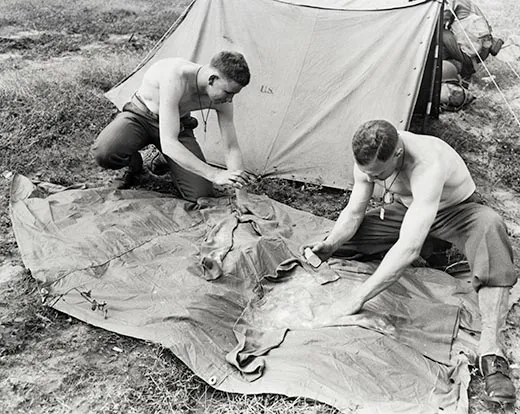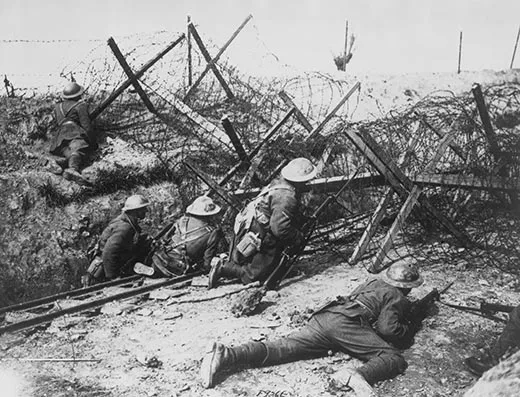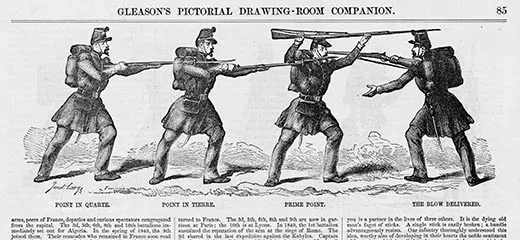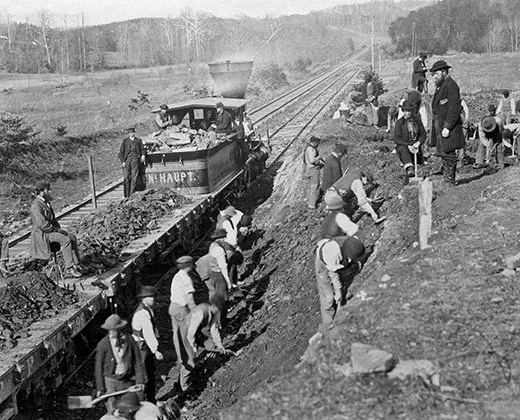Ten Inventions That Inadvertently Transformed Warfare
Some of the most pivotal battlefield innovations throughout history began as peacetime inventions
/https://tf-cmsv2-smithsonianmag-media.s3.amazonaws.com/filer/warfare-barbed-wire-631.jpg)
Bayonet: In the early 17th century, sportsmen in France and Spain adopted the practice of attaching knives to their muskets when hunting dangerous game, such as wild boar. The hunters particularly favored knives that were made in Bayonne—a small French town near the Spanish border long renowned for its quality cutlery.
The French were the first to adopt the “bayonet” for military use in 1671—and the weapon became standard issue for infantry throughout Europe by the turn of the 17th century. Previously, military units had relied on pikemen to defend musketeers from attack while they reloaded. With the introduction of the bayonet, each soldier could be both pikeman and musketeer.
Even as modern weaponry rendered bayonets increasingly obsolete, they endured into the 20th century—in part because they were deemed effective as psychological weapons. As one British officer noted, regiments “charging with the bayonet never meet and struggle hand to hand and foot to foot; and this for the best possible reason—that one side turns and runs away as soon as the other comes close enough to do mischief.”
Barbed Wire: Invented in the late 19th century as a means to contain cattle in the American West, barbed wire soon found military applications—notably during the Second Anglo-Boer War (1899-1902) in what is now South Africa. As the conflict escalated, the British Army adopted increasingly severe measures to suppress the insurgency led by Dutch settlers.
One such measure was constructing a network of fortified blockhouses connected by barbed wire, which limited the movement of the Boers in the veldt. When British forces initiated a scorched-earth campaign—destroying farms to deny the guerrillas a means of support—barbed wire facilitated the construction of what was then termed “concentration camps,” in which British forces confined women and children.
More than a decade later, barbed wire would span the battlefields of World War I as a countermeasure against advancing infantry. A U.S. Army College pamphlet published in 1917 succinctly summarized the advantages of a barbed-wire entanglement:
“1. It is easily and quickly made.
2. It is difficult to destroy.
3. It is difficult to get through.
4. It offers no obstruction to the view and fire of the defense.”
Steamship: “The employment of steam as a motive power in the warlike navies of all maritime nations, is a vast and sudden change in the means of engaging in action on the seas, which must produce an entire revolution in naval warfare,” wrote British Gen. Sir Howard Douglas in an 1858 military treatise.
He was correct, although this revolution in naval warfare was preceded by a gradual evolution. The early commercial steamships were propelled by paddle wheels mounted on both sides of the vessel—which reduced the number of cannons a warship could deploy and exposed the engine to enemy fire. And a steamship would need to pull into port every few hundred miles to replenish its supply of coal.
Still, steamships offered significant advantages: They were not dependent upon the wind for propulsion. They were fast. And they were more maneuverable than sailing ships, particularly along coastlines, where they could bombard forts and cities.
Arguably the most important enabler of steam-powered warships was the 1836 invention of the screw propeller, which replaced the paddle wheel. The next major breakthrough was the invention of the modern steam turbine engine in 1884, which was smaller, more powerful and easier to maintain than the old piston-and-cylinder design.
Locomotive: Justus Scheibert, an officer in the Royal Prussian Engineers, spent seven months with the Confederate Army observing military campaigns during the Civil War. “Railroads counted in both sides’ strategies,” he quickly concluded. “Trains delivered provisions until the final moments. Therefore the Confederacy spared nothing to rebuild tracks as fast as the enemy destroyed them.”
Although railroads had been occasionally used during the Crimean War (1853-1856), the Civil War was the first conflict where the locomotive demonstrated its pivotal role in rapidly deploying troops and material. Mules and horses could do the work, though far less efficiently; a contingent of 100,000 men would require 40,000 draft animals.
Civil War historians David and Jeanne Heidler write that, “Had the war broken out ten years before it did, the South’s chances of winning would have been markedly better because the inequality between its region’s railroads and those of the North would not have been as great.”
But, by the time war did break out, the North had laid more than 21,000 miles of railroad tracks—the South had only about a third of that amount.
Telegraph: The Civil War was the first conflict in which the telegraph played a major role. Private telegraph companies had been in operation since the 1840s—a network of more than 50,000 miles of telegraph wire connected cities and towns across the United States when war erupted.
Although some 90 percent of telegraph services were located in the North, the Confederates were also able to put the device to good use. Field commanders issued orders to rapidly concentrate forces to confront Union advances—a tactic that led to victory in the First Battle of Bull Run, in 1861.
Arguably the most revolutionary aspect of the device was how it transformed the relationship between the executive branch and the military. Before, important battlefield decisions were left to the discretion of field generals. Now, however, the president could fully exercise his prerogative as commander in chief.
“Lincoln used the telegraph to put starch in the spine of his often all too timid generals and to propel his leadership vision to the front,” writes historian Tom Wheeler, author of Mr. Lincoln’s T-Mails. “[He] applied its dots and dashes as an essential tool for winning the Civil War.”
Caterpillar tractor: During World War I, engineers sought to design a war machine robust enough to crush barbed wire and withstand enemy fire, yet agile enough to traverse the trench-filled terrain of no man’s land. The inspiration for this armored behemoth was the American tractor.
Or, more specifically, the caterpillar tractor invented in 1904 by Benjamin Holt. Since the 1880s, Holt’s company, based in Stockton, California, had manufactured massive, steam-powered grain harvesters. To allow the heavy machines to traverse the steep, muddy inclines of fertile river deltas, Holt instructed his mechanics to replace the drive wheels with “track shoes” made from wooden planks.
Later, Holt sought to sell his invention to government agencies in the United States and Europe as a reliable means for transporting artillery and supplies to the front lines during wartime.
One person who saw the tractor in action was a friend of Col. E. D. Swinton of the Engineering Corps of the British Army. He wrote a letter to Swinton in July 1914 describing “a Yankee machine” that “climbs like hell.” Less than a year later, Swinton drafted specifications for a tank—with a rhomboid shape and caterpillar treads—designed to cross wide trenches. It later became known as “Big Willie.” The tanks made their combat debut during the Battle of the Somme on September 15, 1916.
As historian Reynold Wik has noted, “the first military tanks had no American parts, neither motors, tracks, nor armament. However. . . the technological innovation which occurred in Stockton in November 1904 had proved that heavy machines could be moved over difficult terrain with the use of track-type treads.”
Camera: Aerial photographic reconnaissance came of age in World War I, thanks to higher-flying planes and better cameras. Initially, planes were deployed to help target artillery fire more accurately. Later, they were used to produce detailed maps of enemy trenches and defenses, assess damage after attacks and even scout “rear echelon” activities to glean insights into enemy battle plans. Baron Manfred von Richthofen—“the Red Baron”—said that one photoreconnaissance plane was often more valuable than an entire fighter squadron.
The opposing armies took measures to thwart photographic reconnaissance. Potential ground targets were disguised with painted camouflage patterns. (The French, naturalment, enlisted the help of Cubist artists.)
Of course, the most effective countermeasure was to mount guns on planes and shoot down the observation aircraft. To provide protection, fighter planes escorted reconnaissance craft on their missions. The era of the “dogfight” began—and with it the transformation of the airplane into a weapon of warfare.
Chlorine: Historians generally agree that the first instance of modern chemical warfare occurred on April 22, 1915—when German soldiers opened 5,730 canisters of poisonous chlorine gas on the battlefield at Ypres, Belgium. British records indicate there were 7,000 casualties, 350 of which were lethal.
German chemist Fritz Haber recognized that the characteristics of chlorine—an inexpensive chemical used by the German dye industry—made it an ideal battlefield weapon. Chlorine would remain in its gaseous form even in winter temperatures well below zero degrees Fahrenheit and, because chlorine is 2.5 times heavier than air, it would sink into enemy trenches. When inhaled, chlorine attacks the lungs, causing them to fill with fluid so that the victim literally drowns.
In response, all sides sought even more lethal gases throughout the remainder of the conflict. Chlorine was an essential ingredient in manufacturing some of those gases—including the nearly odorless phosgene, which was responsible for an estimated 80 percent of all gas-related deaths in World War I.
DDT: In the late 1930s, with war on the horizon, the U.S. military undertook preparations to defend soldiers against one of the most lethal enemies on the battlefield: insect-borne diseases. During World War I, typhus—a bacterial disease spread by lice—had killed 2.5 million people (military and civilian) at the eastern front alone. Health specialists also worried about the prospect of mosquito-borne diseases, such as yellow fever and malaria, in the tropics.
The military needed an insecticide that could be safely applied as a powder to clothes and blankets. Initially synthesized by an Austrian student in 1873, DDT (dichlorodiphenyltrichloroethane) remained a laboratory oddity until 1939, when Swiss chemist Paul Müller discovered its insecticidal properties while researching ways to mothproof wool clothing. After the military screened thousands of chemical compounds, DDT eventually emerged as the insecticide of choice: it worked at low dosages, it worked immediately and it kept working.
DDT proved to be so effective that some historians believe World War II was the first conflict where more soldiers died in combat than from disease. Yet, even before the war ended, entomologists and medical researchers warned that the insecticide could have long-term, dangerous effects on public health and the environment. The United States banned DDT in 1972.
Tide-Predicting Machine: As the Allies planned their invasion of Europe in 1944, they faced a dilemma: Should they land on the beaches of Normandy at high tide or low tide?
The argument in favor of high tide was that troops would have less terrain to cross as they were subjected to enemy fire. However, German Gen. Erwin Rommel had spent months overseeing the construction of obstacles and booby traps—which he called a “devil’s garden”—to thwart a potential Allied landing. During high tide, the devil’s garden would be submerged and virtually invisible; but during low tide it would be exposed.
Ultimately, military planners concluded that the best conditions for an invasion would be a day with an early-morning (but steadily rising) low tide. That way, landing craft could avoid the German obstacles, and Army engineers could begin clearing them away for subsequent landings.
To complicate matters, the Allies also wanted a date when, prior to the dawn invasion, there would be sufficient moonlight to aid pilots in landing paratroopers.
So the Allies consulted meteorologists and other experts to calculate the dates when the tides and the moon would meet the ideal conditions. Among those experts was Arthur Thomas Doodson, a British mathematician who had constructed one of the world’s most precise tide-predicting machines—which reduced the risk of ships running aground when entering a harbor. Doodson’s machine was essentially a primitive computer that produced calculations using dozens of pulley wheels. Doodson himself calculated the ideal dates for the D-Day invasion—a narrow set of options that included June 5-7, 1944. The Allied invasion of Europe commenced on June 6.
/https://tf-cmsv2-smithsonianmag-media.s3.amazonaws.com/accounts/headshot/mark-strauss-240.jpg)




/https://tf-cmsv2-smithsonianmag-media.s3.amazonaws.com/accounts/headshot/mark-strauss-240.jpg)